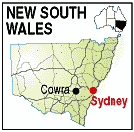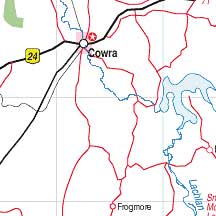
|
|
Cowra developed at a point where the Lachlan River was most easily forded,
facilitating trade links between the western plains of NSW and the south.
During World War 2, 234 Japanese POW's died during a mass escape attempt from the Cowra camp which held them and 4 Australians were killed by escaping Japanese. That event has become the catalyst to focus community endeavour to promote international peace and fellowship. The Japanese Garden and Cultural Centre, a traditional and authentic Japanese garden is a notable achievement to promote harmony. An avenue of 800 cherry trees have been planted to connect the local war cemeteries to the Cultural Centre. Annualy, 'The Festival of International Understanding', extends invitations to nations to participate. A replica of the World Peace Bell which hangs in the United Nations building. New York, has been presented to Cowra in recognition of its promotion of international understanding. The hinterland of Cowra produces gourmet meats, fine wines, vegetable products, prime lamb and beef. Lake Wyangala, south-east from the town, is a popular holiday destination with accommodation and camping facilities. The clear, clean waters are ideal for water sports, fishing and fun. There are bushwalking trails and picnic areas. The very scenic location and diverse array of activities, make Cowra a worthwhile interlude for travellers. A definite stop is the Mid State rail Museum at Caravan City on the Sydney Rd, just east of Cowra. Working displays and the largest model railway in Australia can be seen.It also has a POW and Military Museum as well and is open daily. It was named "Broadway" due to a number of lights for security at night. It was 750 yards (680 metres) long. Running at right angles across this strip was another but narrower area, called No Man's Land. Entrances to each of the compounds A, B, C and D was from Broadway and the only way into Broadway was through two large double gates at either end. Surrounding each compound was a separate perimeter fence consisting of three barbed wire fences, 30 feet (9 metres) apart. Inside the spaces was a mass of barbed wire. Outside the perimeter the guards did their sentry duty and patrolled on a raised earthen walkway called the 'catwalk'. A series of large towers surrounded the perimeter as well. The 22nd Australian Garrison Battalion responsible for guarding the prisoners had a company of guards at each compound (A, B, C and D). The Group headquarters was established an high ground on the western side overlooking the whole camp. The Guards of POW camps were sometimes maligned and not thought of as 'real soldiers'. This was an unfortunate attitude and one based on ignorance of the facts. Many of the guards were Great War veterans, some had already served in North Africa and others were younger, but medically unfit men. In August 1944, overcrowding due to the number of new Japanese prisoners was becoming a problem. On the 4th August 1944, it was decided to move all Japanese from below the rank of Lance Corporal to the camp at Hay. The Japanese leaders at the Cowra camp were told the same day. Interviews with Japanese witnesses after the Breakout determined that a series of emergency meetings were then held. The Japanese voted unanimously to attack the perimeter. The attack was launched at 1.50am on the 5th August 1944, but only from B compound. There were 4 escape points. Two waves attacked the perimeter directly at the Vickers machine gun manned by Private Jones and Private Hardy. Another group attacked the eastern perimeter and two groups exited into Broadway. This group then split and one half attacked the northern end and the other attempted to link up with Japanese officers in Compound D to the south. No Japanese POW escaped from Broadway. The total death toll was 231 Japanese killed (3 more were to die of wounds later) and 4 Australian soldiers. Another Australian at Blayney died later from accidental gunshot wounds while he was returning from a patrol to find prisoners. Private Charles Shepherd was killed by escaping Japanese and later that day Lt Doncaster was ambushed and killed while searching for escapees towards Canowindra. The last Japanese were captured nine days later. Several had suicided in the bush and others had thrown themselves under trains. The actions of Hardy and Jones went unnoticed by the Australian authorities until pressure was brought to bear from their friends. Years of correspondence between Australia and London (where Imperial Honours were administered), were met with disappointment. The British Government did not recognise these men as having died 'On Active Service'. Finally, through the personal intervention of Prime Minister R.G. Menzies, the award of the George Cross was made some five years after the war. Tragically Madelaine Cook, the widow Private Jones wanted to marry, died in 1948 and Private Hardy's mother died just four days before the George Cross awards were promulgated in the London Gazette on 1st September 1950. Cowra now has many attractions to remember this event and show international understanding such as the Prisoner of War Campsite and Replica Guard Tower, The Cowra and Japanese War Cemetery, The World Peace Bell and the Cowra Japanese Garden and Cultural Centre. The Cowra area is part of Wiradjuri country, one of the largest Aboriginal language groups in Australia. In Wiradjuri Aboriginal dialect, the word coura meant rocks, a name appropriate for a town with rocky granite surrounds. It was about 1847 when the river crossing at Coura Rocks became known as Cowra, a simplified version of the original word and in December two years later it was proclaimed a site, fixed for the village of Cowra. The Lachlan River was named after the Governor Lachlan Macquarie on 27 May 1815. In December 1816 William Cox established a base for the first fully equipped expedition into the interior of NSW, located on high ground between this point and the river. The goal of the expedition was to follow the river to the ocean and the thirteen men on the expedition reached Bathurst on 29 August 1817 and the depot was disbanded. It was the first permanent European settlement on the Lachlan and its locations became known as Soldiers Flat. In 1941 the Australian Army decided to establish a camp for Prisoners of War on the outskirts of Cowra. The camp was intended to hold Germans and Italians from the North Africa Campaign as well as illegal aliens finding themselves in Australia at the outbreak of war. The camp was known as Number 12 P.O.W. Camp (there were 28 such camps in Australia during WWII). It was originally planned as two compounds with tents for accommodation, but when finally built, it consisted of four 17 acre compounds each designed to hold 1000 prisoners enclosed within a twelve sided, almost circular perimeter. Running through the middle of the camp was a main thoroughfare. SEE INDEXED MAP OF COWRA PLACES OF INTEREST: ACCOMMODATION & SERVICES: |

|
© Copyright Peter W. Wilkins | |


